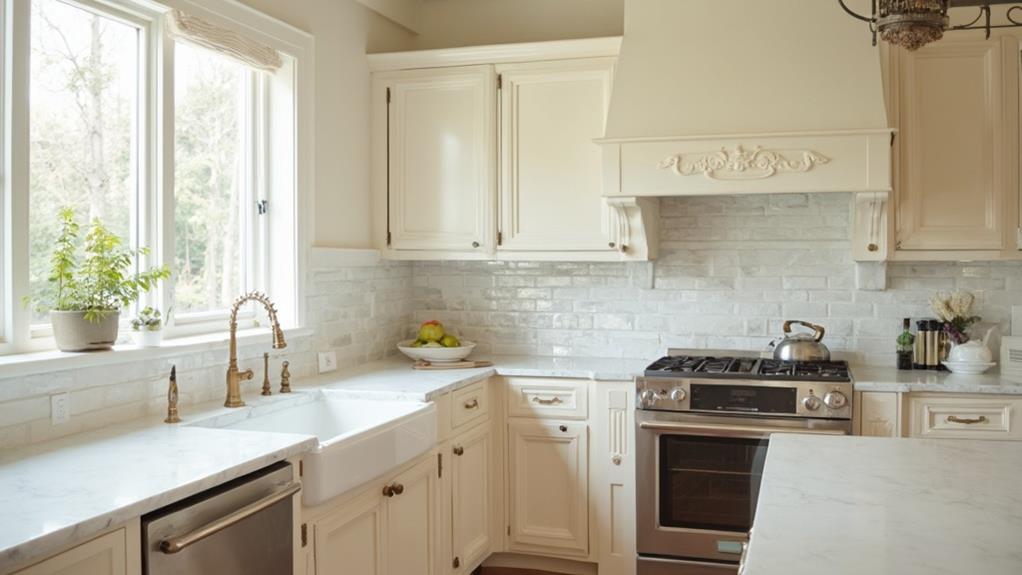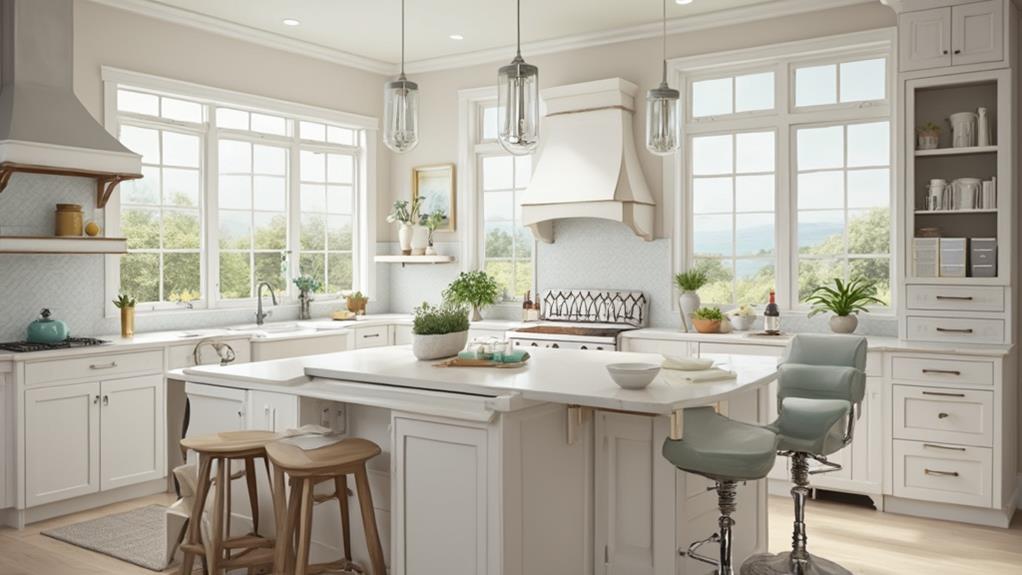To design a kitchen that ages gracefully, focus on timeless elements and practical features. Choose neutral color schemes and invest in high-quality, durable materials like hardwood cabinets and natural stone countertops. Prioritize ergonomic design with adjustable-height surfaces and easy-to-use fixtures. Incorporate flexible storage solutions, such as pull-out drawers and adjustable shelving. Plan for adaptable lighting with layered options and dimmer switches. Select classic, long-lasting fixtures and energy-efficient appliances. By combining these elements, you'll create a kitchen that remains functional and stylish for years to come. Discover more ways to future-proof your kitchen design and enhance its longevity.
Choose Timeless Color Schemes

When it comes to designing a kitchen that stands the test of time, selecting the right color scheme is crucial. Opt for timeless hues that won't feel dated in a few years. Neutral colors like white, cream, beige, and gray provide a versatile backdrop that can easily adapt to changing trends. These shades also create a sense of spaciousness and cleanliness, essential qualities for any kitchen.
Consider incorporating natural elements through wood tones or stone-inspired colors. These earthy hues add warmth and depth to your space while maintaining a classic appeal. If you're drawn to bolder colors, use them sparingly as accents rather than dominant features. Navy blue, deep green, or charcoal can add sophistication without overwhelming the space.
For a cohesive look, choose a color palette with three to five complementary shades. Apply these colors strategically throughout your kitchen, from cabinetry and countertops to backsplashes and appliances. Remember that lighter colors on upper cabinets and walls can make your kitchen feel more open and airy. By selecting a timeless color scheme, you'll create a kitchen that remains stylish and inviting for years to come.
Invest in Quality Materials
Quality materials form the backbone of a kitchen that ages gracefully. When selecting materials for your kitchen, prioritize durability and longevity over passing trends. Opt for solid hardwood cabinets instead of particleboard or MDF, as they'll withstand daily wear and tear better. Choose countertops made from natural stone like granite or quartz, which resist scratches and stains while maintaining their beauty for years.
For flooring, consider porcelain tiles or hardwood, both of which can last decades with proper care. Invest in high-quality stainless steel appliances from reputable brands known for their longevity and performance. When it comes to hardware, select solid brass or stainless steel fixtures that won't tarnish or corrode over time.
Don't overlook the importance of quality plumbing fixtures and faucets. Opt for models with ceramic disc valves and solid brass construction to ensure smooth operation and leak-free performance for years to come. By investing in these durable materials, you'll create a kitchen that not only looks great now but will continue to impress and function well for decades, saving you money on replacements and renovations in the long run.
Prioritize Ergonomic Design

Ergonomic design is crucial for a kitchen that ages gracefully. It ensures comfort and accessibility for users of all ages and abilities.
Start by considering the work triangle—the space between your sink, stove, and refrigerator. Keep these areas close together to minimize unnecessary movement and strain.
Opt for lower countertops or adjustable-height surfaces to accommodate different users and tasks. Install pull-out shelves and drawers in lower cabinets to reduce bending and reaching. Choose easy-to-grip handles for cabinets and appliances, and consider touch-activated faucets for easier use.
Incorporate adequate lighting throughout the kitchen, including task lighting for work areas and ambient lighting to reduce eye strain. Use non-slip flooring materials to prevent accidents, and ensure there's enough space for mobility aids if needed in the future.
Consider wall ovens at eye level instead of traditional ranges to eliminate bending. Install a microwave at counter height or in a lower cabinet for safer access. Lastly, create a designated seating area with comfortable, supportive chairs to encourage rest and socialization while cooking or enjoying meals.
Plan for Flexible Storage
Flexible storage is a cornerstone of a kitchen that ages gracefully. As your needs change over time, your kitchen storage should adapt with you.
Start by incorporating adjustable shelving in cabinets and pantries. This allows you to modify the space as needed, accommodating taller items or creating more compact storage areas.
Consider pull-out drawers and organizers in lower cabinets. They'll make it easier to access items without bending or straining, which becomes increasingly important as you age. Install lazy Susans in corner cabinets to maximize space and improve accessibility.
Don't forget vertical storage options. Use the full height of your kitchen by adding tall cabinets or extending existing ones to the ceiling. This provides extra storage for less frequently used items. Install hooks, magnetic strips, or pegboards on walls to keep frequently used tools within easy reach.
Incorporate multi-functional furniture pieces, like a kitchen island with built-in storage or a pull-out work surface. These adaptable elements can serve different purposes as your needs evolve.
Lastly, plan for future technology integration by including easily accessible power outlets and charging stations in your storage areas.
Incorporate Adaptable Lighting

With the flick of a switch, adaptable lighting transforms a kitchen from a functional workspace to a cozy dining area. To incorporate this versatility, you'll want to layer your lighting options.
Start with ambient lighting, using recessed ceiling fixtures or a central pendant to provide overall illumination. Then, add task lighting under cabinets and above work areas to ensure you have ample light for food preparation and cooking.
Don't forget accent lighting to highlight architectural features or display areas. Install dimmer switches for all your lighting fixtures, allowing you to adjust brightness levels as needed. Consider motion-activated lights for under-cabinet areas or inside drawers, making it easier to find items in low-light conditions. LED strip lighting can be a great addition, offering flexibility in placement and color options.
As you age, you may need more light to see clearly. Plan for this by including extra lighting fixtures or choosing higher-lumen bulbs that you can easily swap in later. Finally, opt for easy-to-reach switches and consider smart lighting systems that you can control with voice commands or smartphone apps, enhancing accessibility as your needs change over time.
Select Durable, Classic Fixtures
While lighting sets the mood, your choice of fixtures defines the kitchen's character and functionality. Opt for high-quality, timeless fixtures that'll withstand daily use and passing trends. Choose faucets with ceramic disc valves for longevity and smooth operation. Brass or stainless steel finishes offer durability and classic appeal. Consider touchless faucets for convenience and hygiene.
For cabinet hardware, select sturdy pulls and knobs in simple, versatile designs. Brushed nickel, oil-rubbed bronze, or polished chrome are enduring choices that complement various styles. Avoid ornate or trendy designs that may quickly date your kitchen.
When it comes to sinks, undermount models in stainless steel or composite materials offer both durability and ease of cleaning. Double-bowl sinks provide versatility for various tasks. For appliances, focus on energy-efficient models with timeless designs. Stainless steel remains a popular choice for its longevity and neutral aesthetic.
Don't overlook smaller fixtures like soap dispensers, towel bars, and pot fillers. These details can enhance functionality while maintaining a cohesive look. By selecting durable, classic fixtures, you'll create a kitchen that remains stylish and functional for years to come.
Conclusion
As you embark on your kitchen design journey, remember that a timeless space is like a fine wine—it only gets better with age. By embracing classic color schemes, investing in quality materials, and prioritizing ergonomics, you'll create a kitchen that stands the test of time. With flexible storage, adaptable lighting, and durable fixtures, you're not just designing a kitchen; you're crafting a legacy. So go ahead, plant the seeds of a space that'll bloom beautifully for years to come.

